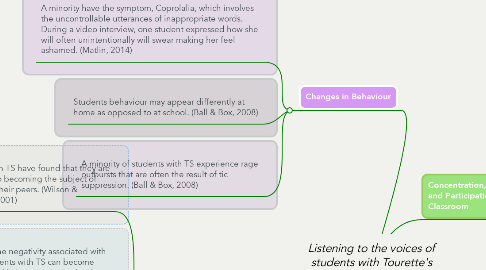Listening to the voices of students with Tourette's Syndrome (TS) in an Education Context
by Georgia Armitage

1. Emotional and Social Wellbeing
1.1. Students with TS have found that they are vulnerable to becoming the subject of bullying by their peers. (Wilson & Shrimpton, 2001)
1.2. Due to the negativity associated with tics, students with TS can become socially withdrawn and may develop a lack of self-esteem. (Matlin, 2014)
1.3. The uncontrollable nature of tics can cause students with TS to become anxious and/or stressed in social situations
1.4. Some students with TS have a tendency to interpret things in a very literal sense causing issues in social situations. (Ball & Box, 2008)
2. Negative Staff and Peer Responses to Tics
2.1. Some staff members may respond to tics by encouraging a student with TS to suppress them. This however requires a lot of energy and will distract the student from engaging in class. (Matlin, 2014)
2.2. Students with TS have expressed that teachers requesting that they leave the classroom during tics leads to them trying to suppress their tics in the future. This negative response would then effect the students potential to concentrate and engage. (Chaturvedi, Gartin, Murdick, 2011)
2.3. In the case study undertaken by BMC Psychiatry, students with TS admitted that they do not report all incidences of teasing and bullying that they experience within the classroom and/or the playground due to the fear of how staff and peers might respond/retaliate. (Wadman, Glazebrook, Beer & Jackson, 2016)
3. Changes in Behaviour
3.1. A minority have the symptom, Coprolalia, which involves the uncontrollable utterances of inappropriate words. During a video interview, one student expressed how she will often unintentionally will swear making her feel ashamed. (Matlin, 2014)
3.2. Students behaviour may appear differently at home as opposed to at school. (Ball & Box, 2008)
3.3. A minority of students with TS experience rage outbursts that are often the result of tic suppression. (Ball & Box, 2008)
4. Concentration, Engagement and Participation in the Classroom
4.1. Students with TS can have difficulty with handwriting due to the interference of hand tics. One student in the BMC Psychiatry case study shared an experience where she rewrote over the top or her words continually to the point where the page was torn. ((Wadman, Glazebrook, Beer & Jackson, 2016)
4.2. Some students with TS lose concentration in the classroom due to focusing to much energy on suppressing their tics. Two thirds of the students participating in a case study admitted to suppressing their tics. (Wilson & Shrimpton, 2001)
4.3. Students with TS can often appear as though they aren't concentrating when in fact they actually are. For example, the student may be doodling in their book to help them concentrate. (Ball & Box, 2008)
4.4. Reading can sometimes become difficult for a student with TS as they may find it difficult to keep their eyes on the task due to motor tics such as rapid eye-blinking, head jerking and eye-grazing.
4.5. During an interview with Olivia Matlin, students with TS shared that they often feel uncomfortable asking and/or answering questions in class out of fear that tics will occur. (Matlin, 2014)
5. Home Life - Completion of Homework and Assessment Tasks
5.1. Some students with TS may have difficulty remaining focused on a task for too long. This may mean that they require homework and assessment tasks that are condensed down into smaller parts. (Chaturvedi, Gartin, Murdick, 2011)
5.2. Children with TS have expressed that they generally suppress tics and emotions throughout the school day which then only get released once they're at home and feel safe to do so. This then affects not only the child's family but also the student's capability to complete homework and assessment tasks effectively. (Chaturvedi, Gartin, Murdick, 2011)


